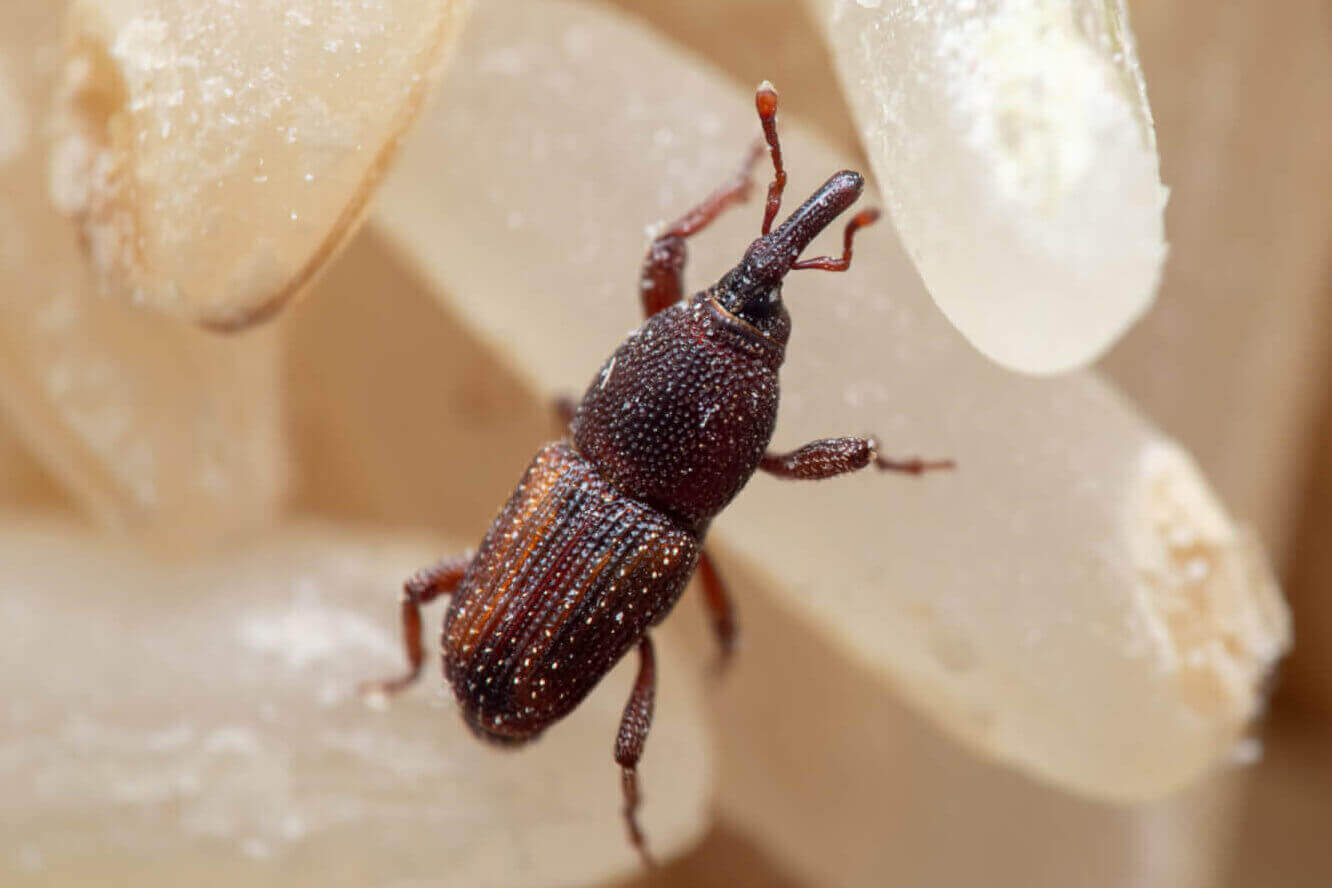Rice Weevil Facts & Information
Everything you need to know about rice weevils
What Do Rice Weevils Look Like

Rice weevils have elongated oval-shaped bodies that can range from reddish brown to black. They have round pits on their thorax and four yellow or red spots on the corners of their forewings. They are uniformly dark brown in colour except for their wing covers, which feature four orange spots. Their thoraxes are covered with rows of punctures that extend down their backs, save for a narrow strip in the middle. Rice weevils can fly and have prominent snouts that protrude from their heads.
Female rice weevils lay about 300 to 400 eggs over the course of their adult lives, a period of time that typically covers four or five months. They chew holes in kernels of grain and deposit their eggs inside. After hatching, immature rice weevils remain housed within the grain and feed on the insides of the kernel. They develop from larvae to pupae before chewing a small, circular exit hole into the grain kernel and emerging as fully mature adults. Unlike adults, rice weevil larvae are white and legless. They have a wrinkled appearance and develop within whole kernels of grain. Consequently, rice weevils are rarely seen during the larval stage of development. Rice weevil larvae are fat, grub-like, legless blobs basically. Their cream-colored body is topped off by a dark head. The length of the rice weevil life cycle is directly affected by the conditions of the surrounding environment. In warmer temperatures, rice weevils may develop from eggs to adults in a matter of weeks. Cooler temperatures, however, significantly lengthen the developmental process. They can infect pantry items quickly so bring in a weevil exterminator if you suspect you’ve got them.Not the weevil you have?
Female rice weevils lay about 300 to 400 eggs over the course of their adult lives, a period of time that typically covers four or five months. They chew holes in kernels of grain and deposit their eggs inside. After hatching, immature rice weevils remain housed within the grain and feed on the insides of the kernel. They develop from larvae to pupae before chewing a small, circular exit hole into the grain kernel and emerging as fully mature adults. Unlike adults, rice weevil larvae are white and legless. They have a wrinkled appearance and develop within whole kernels of grain. Consequently, rice weevils are rarely seen during the larval stage of development. Rice weevil larvae are fat, grub-like, legless blobs basically. Their cream-colored body is topped off by a dark head. The length of the rice weevil life cycle is directly affected by the conditions of the surrounding environment. In warmer temperatures, rice weevils may develop from eggs to adults in a matter of weeks. Cooler temperatures, however, significantly lengthen the developmental process. They can infect pantry items quickly so bring in a weevil exterminator if you suspect you’ve got them.Not the weevil you have?
Where Do Rice Weevils Live
Rice weevils are usually found in grain storage facilities or processing plants where they will infest wheat, oats, rye, barley, rice, and corn. Although not often found in the home, they are sometimes found infesting beans, birdseed, sunflower seeds, dried corn, and to a lesser degree macaroni and spaghetti. They may also infest grain in the field. Larvae hollow out kernels of grain and usually attack whole kernels. Holes in the side of the grain are made by adults and by the emerging adults. They build up in numbers in stored grain as well. So, basically, rice weevils live wherever their food is.
How Did I Get Rice Weevils
Grains infested by rice weevils often increase in temperature and become noticeably heated at the surface. Rice weevil infestations also cause moisture levels to rise, resulting in grain that may feel damp to the touch. Other signs of infestation include the presence of grains with round exit holes chewed into the kernels. You most likely got rice weevils from bringing home a package of the food they like from the grocery store. They aren’t like cockroaches or flies where if you have sanitation strategies in place and keep a very clean home, you most likely won’t get them. buying a package of dried corn that’s infested with rice weevils isn’t your fault. It’s an unfortunate mistake.
If you do get them, make sure to dispose of the infected product immediately. Take out all the other products from the pantry and thoroughly clean and vacuum. Make sure to get into those cracks and crevices because these pests are pretty small. Clean out the vacuum so that you’re not just relocating them instead of getting rid of them. Professional weevil extermination may be necessary for a large infestation.
If you do get them, make sure to dispose of the infected product immediately. Take out all the other products from the pantry and thoroughly clean and vacuum. Make sure to get into those cracks and crevices because these pests are pretty small. Clean out the vacuum so that you’re not just relocating them instead of getting rid of them. Professional weevil extermination may be necessary for a large infestation.
What Problems Do Rice Weevils Cause
Rice weevils pose no harm to people or pets since they don’t sting, bite, or carry diseases. They are a serious annoyance and can do serious damage to seeds, rice, and plenty of other drygoods. If you have them in your pantry or food storage areas, you could be looking at throwing away a significant amount of food stuff – taking a bite out of your wallet as a homeowner and a bite out of your bottom line if you’re a business owner. Better to have the correct weevil treatments done for ultimate weevil control in your home or business.
How Can I Prevent Rice Weevils?
To prevent rice weevils from infesting, grain should be stored in tightly-sealed containers made of glass, metal, or heavy plastic. The containers should be thoroughly cleaned out each time prior to adding new grain. Maintaining the cleanliness of the areas around stored grains can be helpful, as well. Stored food products should also be regularly monitored for changes in temperature and moisture content, mold, and the presence of live insects. Prevention is a difficult proposition since you could unknowingly be bringing them into your home or business inside a closed food package but these tactics can help keep it at a minimum or at least keep the infestation located to the already infested product.
Why Waltham for Rice Weevil Control
We’re passionate about keeping weevils out of your home or business because we live and work here – it’s our neighborhood, too. With our 130 years of experience keeping homes and businesses in Massachusetts, Connecticut, New York, Maine, Vermont, New Hampshire, and Rhode Island safe from pests, Waltham has the experience you can trust.
Satisfaction Guarantee
24-Hour Guaranteed Response
Board Certified Entomologists
Need help with rice weevils?
GET MY QUOTE
“Exceptional service. Prompt and professional. Used for both business and home. Very efficient and honest.”
Agawan, MA
